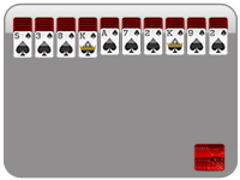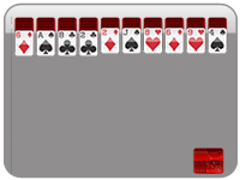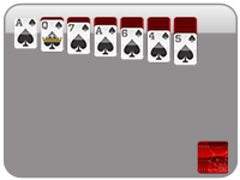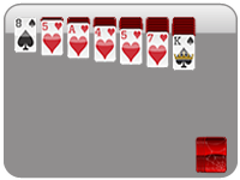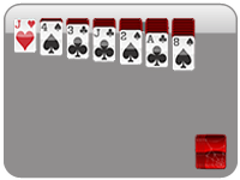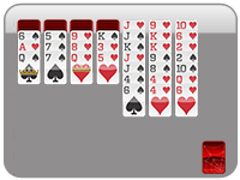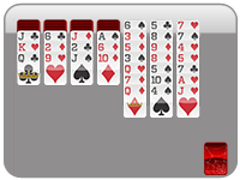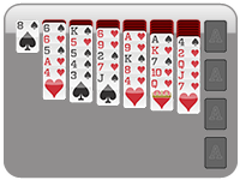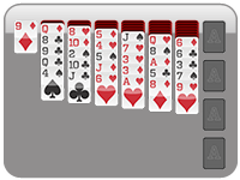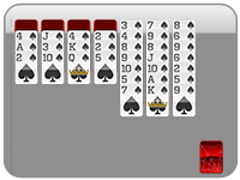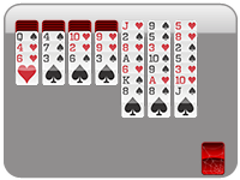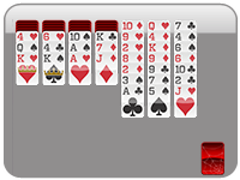The Variations, The Terminology, And Other Interesting Facts
Have you ever heard of Spider solitaire? It’s a variation of the popular game solitaire, and uses two decks to play. Also just known as ‘Spider’, it is named after the eight legs of a spider, referencing the entire goal of the game. But, in this article we’re not going to be discussing the goal of the game, how best to win, or even looking at the rules in that much depth, though we will touch on them briefly. In this piece, we’re going to be looking at the different variations of spider, the terminology that you need to acquaint yourself with in order to play to the best of your ability.
Some people may already be familiar with this information, and if this is the case then that’s fantastic. Perhaps you will find this article of use anyway, giving you some little nuggets that you didn’t even know you needed. You can never have too much knowledge about a subject, so if there’s a chance it might help improve your game, it’s worth the read. If you are interested in understanding more about any of this, you know what to do.
The Variations
Spider has a number of variations. Some people prefer one type, whereas others have a different preference. You don’t need to play them all to determine which one you like, but it might be best just to be on the safe side. But, before you can try them out, you need to understand what they are and what the difference is. It’s pretty self explanatory when you see the names, but we’re going to explain anyway just to make sure that it’s perfectly clear.
1 Suit Spider taire
One suit spider is the simplest form of spider solitaire that you can play. When you learn or are taught the rules, this will usually be for one suit spider as that is where the beginners need to start. This is the most basic form of spider, and is perfect for people who are looking to ease themselves into solitaire.
2 Suit Spider Solitaire
If you want something that is a little more challenging than one suit because you feel like you have a solid grasp on it, then two suit spider solitaire is the next level. It’s pretty much the same as one suit, but with the addition of another suit. Generally, two suit spider is the most favored option because it isn’t too easy, but it doesn’t feel like it’s impossible to win.
4 Suit Spider Solitaire
Four suit spider solitaire is the most difficult variation of the game as there is more to think about, making it a little more complex than the others. We’re sure that you know the rules of spider by now as you wouldn’t be starting straight away with four suits. While you can’t win every game of solitaire anyway, four suit makes it much more difficult, with a lot of people very rarely winning at all.
The Basic Terminology
Understanding the terminology of a game might not matter to some people, but we know how important it is. It makes it easier to understand what is going on, and if you find yourself on a platform that only uses the correct terminology to describe what is happening, it’s good to be in the know. As such, there is some basic terminology that we recommend you learn before you start playing spider solitaire, and we’re going to take a look at some of them right now. Some of them may already be familiar to you, while others might be completely new, even if you have played regular solitaire.
Understanding The Playing Cards
Before you can understand anything about spider solitaire, you need to be familiar with the playing cards. If you already are, then you can skip this section as we won’t be going over anything that you don’t already know.
In a pack of playing cards there are four suits:
- Hearts
- Diamonds
- Clubs
- Spades
There are 13 different ranks and each of the suits has one of each, providing a deck of 52 cards. If your deck has two jokers in it, they need to be removed before you can get started playing spider solitaire. The ranks are as follows from highest to lowest value:
- King
- Queen
- Jack
- Ten
- Nine
- Eight
- Seven
- Six
- Five
- Four
- Three
- Two
- Ace
Of course, if you are playing a card game it is assumed that you understand this beforehand, but we included this just to ensure everyone is clear. Sometimes people get confused about the ace as in some card games it can be the highest card, but in solitaire it’s the lowest.
It’s important to understand that for spider solitaire two packs of cards will be used. They get shuffled together creating one large deck of 104 cards that are used for this game.
Layout
To be able to play the game, you need to understand how the game is laid out. The layout is an important term because it refers to how the game is set up. The table is essentially broken up into three different sections which we are going to look at in a second. It’s true to say that you do not need to know the names of these areas to play the game properly, but it does help to understand the game better if you do.
The Stock
The stock is the area in which the undealt cards are kept. If the player wants to start a new round of spider solitaire, they simply need to click this area and ten cards will be dealt face up onto the tableau. There must be a card in every single column for the game to start, so if you click the stock and this doesn’t happen, it might be worth clicking it again. On an online platform, you may have to refresh the game to get this to work again as there might be an internal site error that needs a quick refresh.
The Tableau
The tableau is where the cards are set. It’s where the majority of the action happened, and is known as the in play area. The tableau will be sectioned horizontally into ten equal-sized unmarked areas, which are referred to as columns. Essentially, this is just the space in which the game is played.
The Foundation
The foundation is where the assembled suits go when they are fully formed. It’s not technically 100% necessary to have this area while you are playing spider solitaire, but it’s a good idea if for no other reason than it helps to keep your cards separated. This ensures that you can keep an eye on your progress as you carry on your game.
Terminology You Need To Understand The Game
Starting Layout
When it comes to the starting layout, there are a few things that you need to know. Now that we have been through the setup of the table and understood the terminology associated with this, we need to do the same with the cards. We’ve discussed the different ranks and suits of the cards, but now you need to know some of the terminology used to describe them in this game.
The starting layout consists of 44 face down cards. Five will go into each of the first columns, and four will go into the other six columns. This is where the term hidden or non-exposed cards comes in.
Hidden cards/Non exposed cards - The first 44 cards, all of which are dealt face down, hiding the rank and suit from the player.
Once these hidden cards have been dealt, there will then be ten cards dealt face up. One is going to be dealt into each of the ten columns on the tableau. These are known as either the visible cards, or the exposed cards.
Visible cards/exposed cards - The ten cards that are dealt face up so that the player can see the rank and suits
Run
If you are going to play spider solitaire, you need to understand the run. In Spider solitaire, the numerical value that is assigned to each rank in other card games is irrelevant, the only important information that you need is the rank and the suit to complete a run.
As you may be aware, in other games of solitaire the order in which the cards need to be ranked can either be ascending or descending, but this is not relevant in spider solitaire. Only descending is relevant for this game, and that is massively important to understand before you get started, or you could end up losing before you begin.
When you manage to organize your cards correctly in a descending order by rank, this is what is known as a run. This is the aim of the game, and this is how you win.
Run - Consecutive cards within the column, ordered by rank which is exactly 1 less than the rank before.
Suited run - A run in which all of the ranks are the same suit.
Non suited run - A run in which the ranks are different suits.
It’s important to understand that in the game of spider solitaire, generally the runs do not need to be suited. However, it depends what kind of level you are playing, and what variation of spider solitaire you have decided on.
Columns And Piles
We touched on columns briefly when we explained the starting layout and why it was important that you understood that terminology. However, columns have a little more to them. It’s common for people to use the words column and pile interchangeably, but they are not the same. The key difference is as follows:
Column - An area where cards are placed within the tableau
Pile - A group of one or more playing cards within a column
If a column does not have any cards in it, it is known as an empty, clear, free, unused, or vacant column. The column does not need to be full of cards to be closed, filled, or used, it only needs to contain one card.
One of the most important things that you need to know about columns is when a player intentionally moves cards to create an empty column. This process can be known as either vacating a column, clearing a column, emptying a column, or opening a column. It’s also good to know that when you place a suited run into an empty column, this is called closing a column.
If a column is closed or used, it cannot be easily vacated, meaning that you are going to have to either look for another column for your next move, or work out something else to win.
Blocked
Another term that you need to be aware of are blocked cards and runs. A blocked card is what occurs when the card on top is the wrong color or in the wrong order. For example if you have the five of clubs is under the four of diamonds, the five won’t be able to move until the four has been taken off of it.
If you are playing one suit spider solitaire, then a blocked card or run has an out of place card at its end. What this means is that if you have a run that goes 9-8-7-2, only the two will be able to move.
Is It All The Same?
The truth is that it’s not all the same. Some people seem to have fallen into the mindset that it is all just the same game over and over again, and while this is true to an extent as the rules do not change, it’s also not accurate. You can set a different level of difficulty depending on what level you are at, how much you want to exercise your brain, and other factors that will help you make a decision. As we’ve explained, the higher number of suits that you are playing, the more difficult the game is going to become.
As you would expect, spider solitaire is slightly different from other variations of the game, of which there are quite a few. You can do some more research into the different variations of solitaire if you are interested in playing others, comparing them to spider, and seeing which ones you prefer. Spider is one of the most popular variations though, so you might find yourself drawn straight back into this one!
Is Spider Solitaire Harder Than Others?
It’s fair to say that because spider solitaire uses an entire extra deck, that it is a little more complex than your regular solitaire. If you are used to playing regular solitaire, it might take a little bit of time for you to adjust to the different tableau and the second deck that is being used.
As we have explained above, there are different levels of difficulty in spider solitaire, but even the most basic form of this is harder than your average solitaire game. It’s harder to win because there are more elements, and it requires more thought.
If you would like something that is a little more simple, it might be worth starting with solitaire, building up your knowledge of the original before moving onto spider. If you do this, you will become familiar with the ideas of runs, columns, piles and some of the other terminology that we have used in this article.
They say that practice makes perfect, so perhaps when you feel confident with regular solitaire, this would be a good step to take. Some people won’t find this helpful though, and prefer to just jump right in so that they don’t have to learn two separate sets of rules. Spider solitaire is pretty much just a more difficult version of the original though due to the extra pack of cards, so while it’s harder, the rules aren’t that much different. It’s up to you how you approach this, but if you are the type who likes to start basic and work their way into the more difficult things, then spider solitaire might not be the best starting point.
Conclusion
We hope that you have found this article informational, and now have a better understanding of some of the variations, terminology and interesting facts when it comes to spider solitaire. The more knowledge that you have before you start playing a game, the better prepared you will be when you get around to playing it! Understanding the terminology that is spider solitaire will help you to have a solid grasp on the rules, and how the table is set up. To some people this might not be massively important, as long as they are able to play the game then they don’t care too much. However, we find that if you find yourself playing a game on a regular basis, it helps you to engage with it more if you understand the terms that professionals would use.
It never hurts to have a solid understanding before jumping right in, and hopefully we have provided you with that.
Spider Solitaire Games
More Solitaire Games
More Games
Spider Solitaire News
Disclaimer
DISCLAIMER: The games on this website are using PLAY (fake) money. No payouts will be awarded, there are no "winnings", as all games represented by 247 Games LLC are free to play. Play strictly for fun.

